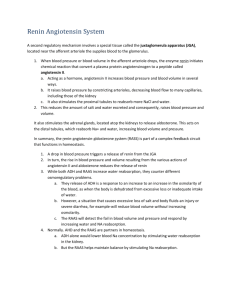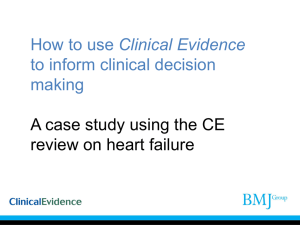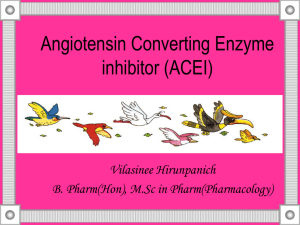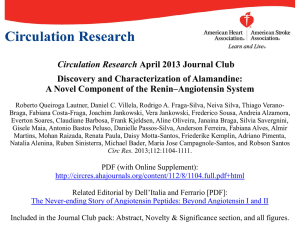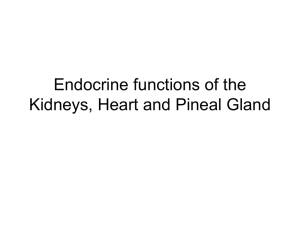L-S-nitrosocysteine preparation
advertisement
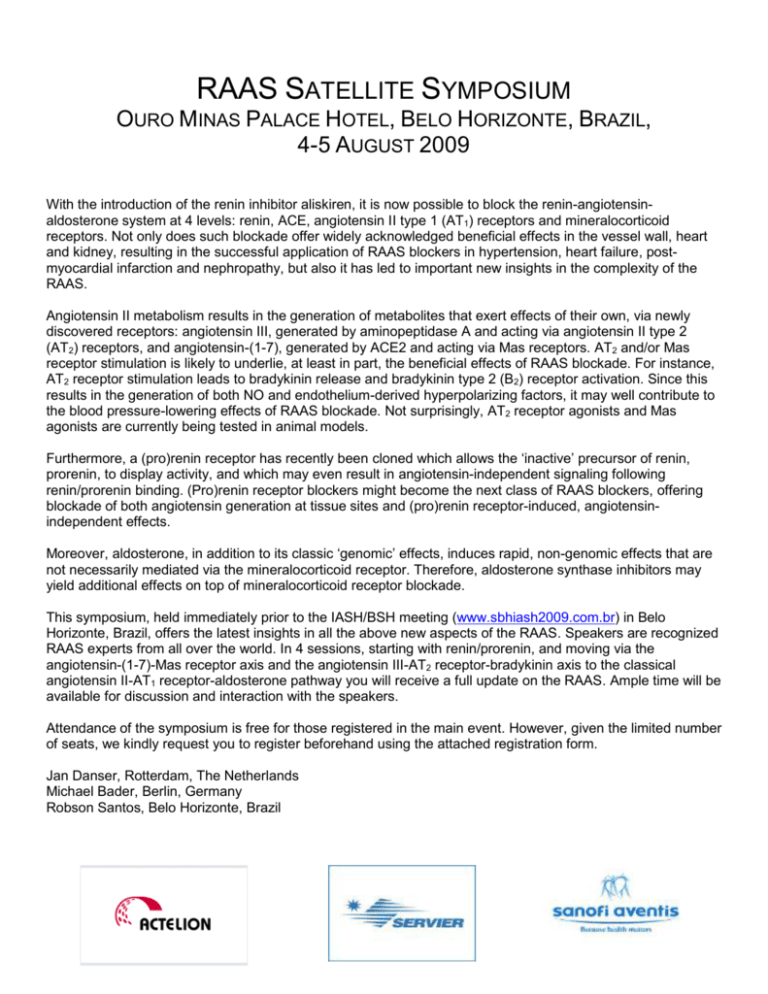
RAAS SATELLITE SYMPOSIUM OURO MINAS PALACE HOTEL, BELO HORIZONTE, BRAZIL, 4-5 AUGUST 2009 With the introduction of the renin inhibitor aliskiren, it is now possible to block the renin-angiotensinaldosterone system at 4 levels: renin, ACE, angiotensin II type 1 (AT1) receptors and mineralocorticoid receptors. Not only does such blockade offer widely acknowledged beneficial effects in the vessel wall, heart and kidney, resulting in the successful application of RAAS blockers in hypertension, heart failure, postmyocardial infarction and nephropathy, but also it has led to important new insights in the complexity of the RAAS. Angiotensin II metabolism results in the generation of metabolites that exert effects of their own, via newly discovered receptors: angiotensin III, generated by aminopeptidase A and acting via angiotensin II type 2 (AT2) receptors, and angiotensin-(1-7), generated by ACE2 and acting via Mas receptors. AT2 and/or Mas receptor stimulation is likely to underlie, at least in part, the beneficial effects of RAAS blockade. For instance, AT2 receptor stimulation leads to bradykinin release and bradykinin type 2 (B2) receptor activation. Since this results in the generation of both NO and endothelium-derived hyperpolarizing factors, it may well contribute to the blood pressure-lowering effects of RAAS blockade. Not surprisingly, AT2 receptor agonists and Mas agonists are currently being tested in animal models. Furthermore, a (pro)renin receptor has recently been cloned which allows the ‘inactive’ precursor of renin, prorenin, to display activity, and which may even result in angiotensin-independent signaling following renin/prorenin binding. (Pro)renin receptor blockers might become the next class of RAAS blockers, offering blockade of both angiotensin generation at tissue sites and (pro)renin receptor-induced, angiotensinindependent effects. Moreover, aldosterone, in addition to its classic ‘genomic’ effects, induces rapid, non-genomic effects that are not necessarily mediated via the mineralocorticoid receptor. Therefore, aldosterone synthase inhibitors may yield additional effects on top of mineralocorticoid receptor blockade. This symposium, held immediately prior to the IASH/BSH meeting (www.sbhiash2009.com.br) in Belo Horizonte, Brazil, offers the latest insights in all the above new aspects of the RAAS. Speakers are recognized RAAS experts from all over the world. In 4 sessions, starting with renin/prorenin, and moving via the angiotensin-(1-7)-Mas receptor axis and the angiotensin III-AT2 receptor-bradykinin axis to the classical angiotensin II-AT1 receptor-aldosterone pathway you will receive a full update on the RAAS. Ample time will be available for discussion and interaction with the speakers. Attendance of the symposium is free for those registered in the main event. However, given the limited number of seats, we kindly request you to register beforehand using the attached registration form. Jan Danser, Rotterdam, The Netherlands Michael Bader, Berlin, Germany Robson Santos, Belo Horizonte, Brazil RAAS SATELLITE BELO HORIZONTE, BRAZIL, 4-5 AUGUST 2009 PROGRAM 4 AUGUST 2009 13.30 – 18.00 HOURS Prorenin/renin/(P)RR/renin inhibition Chair: Jan Danser, Rotterdam, The Netherlands & Geneviève Nguyen, Paris, France 1. Diabetes, renin system blockade and the state of the blood supply to the kidney and the eye Norman Hollenberg, Brigham and Women's Hospital, Boston, Massachusetts, USA 2. The (pro)renin receptor: biology and roles in pathophysiology Geneviève Nguyen, Institut National de la Santé et de la Recherche Médicale, Unit 833 and Collège de France, Paris, France 3. Learning from handle region peptide–effective and –ineffective animal models Atz Ichihara, Department of Internal Medicine, Keio University School of Medicine, Tokyo, Japan 4. Animal models with altered (pro)renin receptor expression Michael Bader, Max-Delbrueck-Center, Berlin, Germany ACE2-Angiotensin(1-7)-Mas axis Chair: Mariella Gironacci, Buenos Aires, Argentina & Robson Santos, Belo Horizonte, Brazil 1. ACE2-Angiotensin(1-7)-Mas axis: an overview Robson Santos, Department of Physiology, Federal University of Minas Gerais, Belo Horizonte, MG, Brazil 2. Angiotensin-(1-7) and protection from hypertensive remodeling in mice Tim L. Reudelhuber, Clinical Research Institute of Montréal (IRCM), Montréal, Canada 3. Role of ACE2 in cardio-pulmonary pathophysiology Mohan K. Raizada, Department of Physiology and Functional Genomics, University of Florida, College of Medicine, Gainesville, Florida, USA 4. Contrasting roles of the renin-angiotensin system in maternal uterus and fetal placenta in normal and preeclamptic pregnancy Bridget Brosnihan, Wake Forest Univ Health Sciences, Winston-Salem, USA RAAS SATELLITE BELO HORIZONTE, BRAZIL, 4-5 AUGUST 2009 PROGRAM 5 AUGUST 2009 08.00 – 12.30 HOURS Aminopeptidase A-Angiotensin III-AT2 Receptor-Bradykinin-B2 Receptor-EDHF axis Chair: Michael Bader, Berlin, Germany & João Pesquero, São Paulo, Brazil 1. Regulation of renal sodium excretion by angiotensin III and AT2 receptors Bob Carey, Division of Endocrinology and Metabolism, Department of Medicine, University of Virginia Health System, Charlottesville, VA, USA 2. Angiotensin AT2 receptor agonism – a new pharmacological concept for anti-inflammation and tissue-protection? Muscha Steckelings, Center for Cardiovascular Research, Charité-Universitätsmedizin Berlin, Berlin, Germany 3. Kinin receptors and obesity. A new role for kinins João B Pesquero, Department of Biophysics, Universidade Federal de São Paulo, São Paulo, Brazil 4. Bradykinin-induced relaxation of coronary arteries: do S-nitrosothiols act as endotheliumderived hyperpolarizing factors? A.H. Jan Danser, Division of Pharmacology, Vascular and Metabolic Diseases, Department of Internal medicine, Erasmus MC, Rotterdam, The Netherlands ACE-Angiotensin II-AT1 Receptor-Aldosterone-Mineralocorticoid Receptor axis Chair: Tim Reudelhuber, Montréal, Canada & Gabriel Navar, New Orleans, USA 1. ACE and AT1 receptor function as angiotensin II-independent mechanotransducers Jose Krieger, Heart Institute/Univ São Paulo Med School, São Paulo, Brazil 2. Structural aspects related to AT1 receptor activation Claudio Costa-Neto, Department of Biochemistry and Immunology – Faculty of Medicine at Ribeirão Preto – University of São Paulo, São Paulo, Brazil 3. Networking between angiotensin II and aldosterone Rhian Touyz, Kidney Research Centre, Ottawa Health Research Institute, University of Ottawa, Ontario, Canada 4. Effects of aldosterone on coronary function Claude Delcayre, INSERM Unit 942 – Université Paris-Diderot, Hôpital Lariboisière, Paris, France RAAS SATELLITE BELO HORIZONTE, BRAZIL, 4-5 AUGUST 2009 REGISTRATION FORM Name : ______________________________________________________________ Affiliation: ______________________________________________________________ ______________________________________________________________ ______________________________________________________________ E-mail: _________________________________________________________________ Attending August 4 Attending August 5 PLEASE SEND THIS FORM TO FAX NUMBER +31 10 7044733 OR SEND AN E-MAIL TO B.BREEMERKAMP@ERASMUSMC.NL
